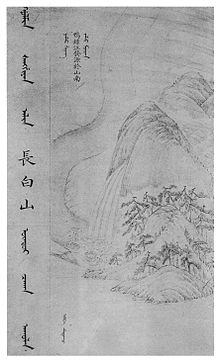Changbai Mountains
| Changbai Mountains | |||||||||
|---|---|---|---|---|---|---|---|---|---|
| Chinese name | |||||||||
| Traditional Chinese | 長白山地 | ||||||||
| Simplified Chinese | 长白山地 | ||||||||
| Literal meaning | Perpetually White Mountain Region | ||||||||
| |||||||||
| Korean name | |||||||||
| Chosŏn'gŭl | 장백산맥 | ||||||||
| Hancha | 長白山脈 | ||||||||
| |||||||||
| Manchu name | |||||||||
| Manchu script | File:Changbai mnc.png Golmin šanggiyan alin | ||||||||

The Changbai Mountain Range (also called Šanggiyan Mountain Range) or Jangbaek Mountain Range (also called Ohnan Mountains) are a mountain range on the border between China and North Korea (41°41' to 42°51'N; 127°43' to 128°16'E). In Russia this range is called "Vostochno-Manchzhurskie gory" ("East Manchurian mountain range") and considered as a part of more long Manchu-Korean mountain range ("Manchzuro-Koreiskie gory"), which separates China from Korea and Russian Primorsky Krai. The range extends from the Northeast Chinese provinces of Heilongjiang, Jilin and Liaoning to the North Korean provinces of Ryanggang and Chagang. Most peaks exceed 2,000 metres in height, with the highest mountain being Baekdu Mountain.
History
The range represents the mythical birthplace of Bukūri Yongšon, ancestor of Nurhaci and the Aisin Gioro Imperial family, who were the founders of the Manchu state and the Chinese Qing Dynasty. The name literally means "Perpetually White Mountain Region" in Mandarin Chinese.
Changbaishan Nature Reserve, established in 1960, was involved in the UNESCO's "Man and Biosphere" program in 1980 and becomes part of the world's biosphere reserves. Approved by the State Council in 1986, it becomes a State-level reserve.
Economy
The range plays an important economic role. It is known for a variety of ginseng that grows there. In addition, the heavily-forested slopes are an important area for logging. In recent years, tourism has also become an increasingly important source of revenue on the Chinese side.
Geography and climate
The highest mountain is Baekdu Mountain (2,745 m), a volcano which is also known locally in China as Changbai Mountain. Baekdu Mountain is the source of the Songhua, Tumen (Tuman) and Yalu (Amnok) rivers. Many tributaries of the Liao He also originate from the Changbai Mountains.
The climate in the mountains is very cold during winter, with absolute minima on the highest peaks in January as low as −45°C (−49°F), but reaching 17°C (62°F) in July. Precipitation is low in the winter but in the higher parts very high in the summer, with annual averages reaching as high as 1,150 mm (45 inches) and over 300 mm (12 inches) in July alone. The dry winters mean there are no glaciers even on the highest and wettest peaks, but permafrost extends down to 1,800 metres (5,900 feet) and is continuous on the highest peaks.
Flora and fauna

The rugged terrain of the Changbai Mountains provides refuge for many rare animals, including bears, and Siberian tigers. A large portion of the Jilin Province side is protected as the Changbai Nature Reserve (長白山自然保護區), which covers more than 2,100 square kilometres.
The vegetation of the mountain slopes is divided into several different zones. At the top, above 2000 metres, tundra predominates. From 1700 to 2000 metres, vegetation is dominated by mountain birch and larch. Below this zone, and down to 1100 metres, the dominant trees are spruce, fir, and Korean pine. From 600 to 1100 metres, the landscape is dominated by mixed forest, consisting of Amur linden, Korean pine, maple, and elm. Further down, a temperate hardwood forest is found, dominated by second-growth poplar and birch. (Liu et al., p. 3388).
Protected areas
See also
- Baekdu Mountain
- Changbai Waterfall
- Geography of China
- Geography of North Korea
- List of mountains in Korea
References
- Liu, Q.J., Takamura, T., Takeuchi, N., Shao, G. (2002). Mapping of boreal vegetation of a temperate mountain in China by multitemporal LANDSAT imagery. International Journal of Remote Sensing 23(17), 3385–3405.
External links
- National Geographic ecosystem profile
- UNESCO profile of Changbaishan Biosphere Reserve
- CHANGBAI MOUNTAIN
